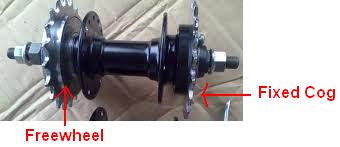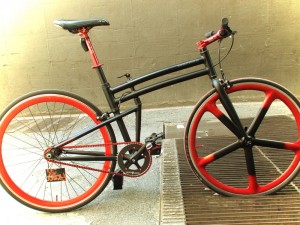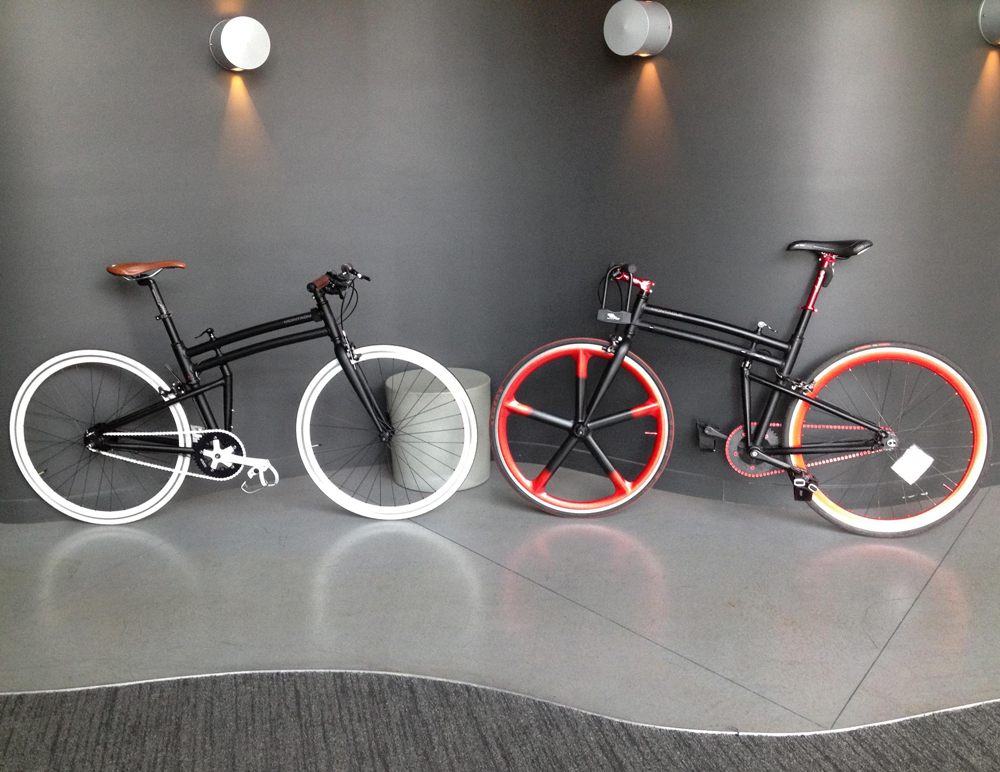If you ride the Montague Boston, or if you’re interested in the bike, you may already know about one of its more interesting features: the flip-flop rear wheel.
The Boston is a single speed bike, which means no gears and no derailleur. But that doesn’t mean that you don’t get a little bit of choice.
On a regular rear wheel, there are cogs on just one side of the hub – the drive side. On a flip-flop rear wheel, there is a single cog on either side of the hub (although you only use one at any given time). One of is a fixed cog, and the other is a freewheel. The freewheel body means that the rear wheel can turn even when you’re not pedaling. In a word, it allows you to coast.

A Flip-Flop Hub (such as the one on the Montague Boston) has a cog on either side – one that is fixed and the other that freewheels.
On a fixed gear, you can’t coast. If the bike is moving, your legs need to be moving. While you can’t coast, you can use reverse pressure on the pedals (i.e. pedaling backwards) as a way to control your speed. Some people who ride fixed remove their brakes, relying solely on backwards pressure to control their stop. We don’t recommend this. Whatever feeling of “oneness” this might give you with your bike, a brake is too important a safety feature to mess around with. (The Boston comes with both front and rear brakes, of course).
If you’ve never ridden a fixed gear bicycle, you might be wondering why on earth anyone would ride a bike that doesn’t allow them to coast. Fixed gear bicycles actually predate freewheel technology, but now that we’ve got the choice, which choice should you make?
Why Ride Fixed?

A customized Boston folding bike – those power grips on the pedals suggest a fixed gear rider. Build by Bradley Baysinger
One place you’ll always find fixed gear bicycles (and brakeless fixed gear bicycles at that) is at the track, or velodrome. (You’ll see this summer at the London Olympics). Part of the challenge of track racing is finding a gear ratio that’s low enough that you can start quickly, but high enough that you still have a high top speed. They ride fixed gear brakeless bikes because on a track where there are multiple riders moving at high speeds very close to one another, you don’t want anyone to be able t slam on their brakes and stop quickly. Using backwards pressure on the pedals is a much slower way of stopping. Not so good in rush hour traffic, but great for a closed environment like a velodrome. It stops competitors from riding into one another.
Some people like to ride fixed gear bicycles because they think it’s better exercise. If you’ve got to pedal to move the bike, then you’re moving your legs even on the down hills. This means you’re burning more calories than you would otherwise. Of course you need to be careful going down big hills. If you work up too much speed, your legs are going to be exhausted from spinning upwards of 150 RPM.
Still others ride fixed because they feel like it helps them work on their pedal stroke. Again, not so important for the commuter, but for people who race, or are serious about bike touring or randonneuring, having a smooth pedal stroke is really important. A “good” pedal stroke is a circle, not a square. Think about it as moving your foot through the bottom of the pedal stroke in a circular motion, rather than pumping your legs up and down. In any case, fixed gear bicycles are supposed to help people who want to develop a better pedal stroke.
Riding a fixed gear bicycle also means you can “track stand” (balance on the bike without moving forward). You can do this by using the pedals to edge just a tiny bit forwards or backwards. This is handy when you’re racing at the track (hence track stand), and you need to be clipped into your pedals starting from a dead stop. If you’re commuting, and you commute with clipless pedals, you might also be interested in riding a fixed gear because you won’t have to unclip at every stop – you’ll just be able to balance. (Although some people have expressed safety concerns about this as well).
Perhaps most importantly, a fixed gear bicycle lets you ride backwards. On a freewheel, if you pedal backwards, nothing happens. On a fixed gear bicycle, if you pedal backwards (from a standstill), you’ll go backwards. Again, not so useful in traffic, but fun tricks to work on.
Why Ride Free?
I’m going to go ahead and say that there’s a reason freewheel technology became the standard in the market. Coasting is fun. Coasting means you can go really fast down a big hill without moving your legs. It’s one of the things that makes riding a bike better (in my humble opinion) than walking/running. It’s also easier than riding fixed gear (I think). I mean, how many little kids out there learn to ride on a fixed gear bicycle? My guess is not many.
Freewheel bicycles also allow you to have multiple gears. I’ve thought for a long time about whether it would be possible to have a fixed gear multi-speed bike, and I don’t think it is (although I’d be interested to know if anyone thinks differently). For one thing, I don’t think that the derailleur could take the pressure of backwards pedaling, and secondly, even if it could, I think that backwards pedaling would really mess with the shifting. Your thoughts?
How Do You Ride Your Montague Boston?
Do you have your Boston on the fixed side or the freewheel side? Which do you prefer? What factors featured in your choice? Do you go back and forth between the two? Also, for more photos of customized Montague bikes, check out our gallery. Have photos of your own custom build that you want to share? Post to our Facebook Page or find us on Pinterest!





If a traditional gear cluster was FIXED to the wheel and had a traditional derailleur,
whenever the rider pedaled slower than the wheels, it would:
– switch the tension from the top of the chain to the bottom
– jerk the bottom span of chain taut, and
– snap the derailleur arm forward
With no derailleur arm on the now-slack top of the chain, it could easily derail from the top of the front chainring.
So, only the one gear large enough to keep the chain taut top & bottom would work.
Interestingly, it might work with:
– a set of opposite-facing gear clusters matched to have the same chain-path length in all positions, and
– a front-type derailleur tall enough to push the top AND bottom halves of the chain.
Even that might not work.
IF it worked at all, I’d expect
– shifting to a higher gear would be easier while pedaling, and
– shifting to a lower gear would be easier while coasting
since
– shifting would be easier on the less-tense half of the chain, and
– the chain could only shift to a larger cog AFTER shifting to a smaller one in the other cluster.
I’m looking for a gear system where i can be free wheel and change to fix gear on demand .i need fix gear to ride backwards.i don’t want to have fixed gear going forwards . is this possible .
The flip-flop hub is the closest thing you’re going to find to a switch to fixed gear on demand, but as the post says you do have to flip the wheel over to move from the free wheel side to the fixed gear side. Many years ago a company called Sturmey Archer made an internally geared hub that functioned like a fixed gear, as in you always had to pedal, but there were three gearing options. These are very rare and highly sought after by collectors, but even still I do not think it is what you’re looking for.
https://www.amazon.com/Sturmey-Archer-S3X-3-speed-fixie-130mm/dp/B0042R50QQ
The only reason I can see to change from fixie to free would be when you were going from a flat area to a hilly one. But then you’d want the 2 cogs to be different sizes, something that would mean you’d have to change the chain length to do the swap. But if you could work that out, it would be fun.
There is one shifting fixie hub that I know of, and it uses planetary gears. Unfortunately, it is designed specifically for unicycles. Google “Schlumpf Hub” to see it in its full glory. There’s probably something similar for bikes, but I come from a unicycle background.
Very cool. It actually looks like they do make a Schlumpf drive for bicycles. The shifting is accomplished in the crankset/bottom bracket and it can be used with a fixed cog! Here’s one example: http://cyclemonkeylab.blogspot.com/2013/08/cinelli-gazzetta-with-schlumpf-mountain.html
With two chain-rings and two Surly Dingles (two cogs, such as 17/21, fused together), one Dingle on the fixed side and one Dingle on the freewheel side, you get two gear ratios and fixie/freewheel with one chain length. Of course you have to stop and get off to shift configuration. Couple this with a Schlumpf at the bottom bracket and it becomes 4 gear ratios. Sounds like something I might put together in the future.